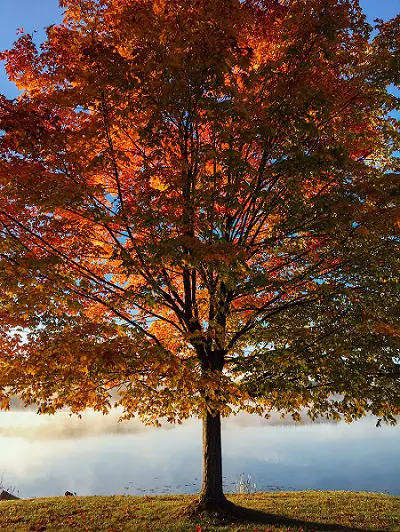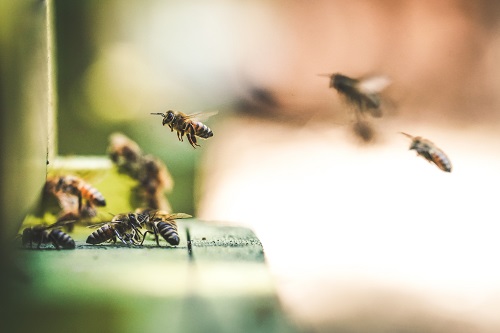10 Types of Trees You Can Grow in Your Garden If You Live in Cold Weather Areas
Planting a tree in your own backyard or garden can be one of the best things you would do for yourself and the environment. But what’s the first thing that comes to your mind when you think of winter gardens? Grey, brown, and cold, right? Well not necessarily! They might be cold but definitely not grey and dull. The key, you may ask? You just need to look for the trees that are hardy enough to grow in colder regions and yet at the same time, can produce contrasting fruit or flowers that would be a refreshing break in the winter skies. Also, pick the perfect spot for your tree to grow where it can flourish in the best possible way. Here is a complete guide on ten winter hardy trees that will look beautiful in your garden space.
1. Maple
The maple tree has almost 125 species. Out of these, the red maple tree is the most popular one. Some spices that reach up to the height of max 30 feet are best considered to plant in your yards. They have beautiful foliage with perfect autumn color leaves. Some of the varieties include Amur, full moon maple, golden full moon maple, and paperbark maple. Sugar maple is one species that is easiest to grow. Well yes, that’s where you get your maple syrup from!

Tree Height:
Most maple trees can reach heights of 33- 148 feet.
Care Requirements:
The maple tree thrives in full sun exposure but can do well in partial shade as well. Make sure the soil is moist but well-drained.
Plantation Tips:
Plantation for maple trees is best done in the fall. Just make sure the ground is not frozen when planting the seeds
If you want to increase the number of birds you see in your yard and have them return every day, read this complete guide to attract birds to your backyard, fast!
2. Oak
Another winter hardy tree that is a favorite is the oak tree. Choosing the right location to plant is of utmost importance. Planting an oak in your backyard can be a big step towards helping the environment as they absorb a large number of air pollutants. A great source of acorn (fruit of the oak tree) for the wildlife, red oak is known to be the fastest-growing type. Transplanting oak trees is a big no-no as it develops a root system that is very strong and huge when it is still young.

Tree Height:
The average height of this tree is 20 meters but there are exceptions of 40-45 meter high trees.
Care Requirements:
They need ample watering as soon as they are planted or germinated. We recommend not using fertilizers as oaks don’t prefer high levels of nitrogen. Oaks can do well in full sunlight as well as partial.
Plantation Tips:
If you plant an acorn, it will germinate right away in the fall. You do remember the Donald Duck cartoons where the chipmunks were always stocking up on their acorn collection. Well, let’s just say you need to protect the plant from chipmunk attacks until the plant starts emerging from the soil.
3. Willow
You must have heard the name weeping willow quite often. These are wood trees. If you have a big yard or have a lake house then this tree is perfect for you. Having originated from China, now it can be found in America and Europe as well. In autumn, the color of the leaves changes to a lovely yellow. It has one of the strongest root systems, even stronger than the stem.

Tree Height:
Weeping willows are very fast-growing and can grow at an incredible rate of 8-10 feet per year. Rare types can grow up to the height of 70 feet but an average height is between 35-50 feet.
Care Requirements:
It needs a hefty amount of water to grow. Moisture and sunlight are two very important factors for the growth of willow trees.
Plantation Tips:
Planting near power lines (underground) or sewers should be avoided as weeping willows have a very extensive root system. These can also clog underground pipes.
4. Camellias
Camellias are very long-lived trees that provide yearlong heavy foliage with gorgeous pink, white and red flowers. The good news for pet keepers as this tree is nontoxic. It’s a tree perfect for cold weather areas but still, it needs protection from the snow and frost. The best way to deal with this problem is to cover your tree with a fleece cloth. If the flowers do not open in the morning, it is probably because of frost damage. There are many camellia varieties out there out of which the Crimson King and the water lily are quite famous. Camellias can be easily propagated by hardwood cuttings.

Tree Height:
Camellias can grow up to the range of 6-15 feet tall.
Care Requirements:
Direct sunlight is not considered good for the plant as it tends to dry up the flowers quickly. Camellia grows only in acidic soil. Deadheading, as soon as the flowers start turning brown, is very healthy for the tree. Watering them with rainwater is the best solution for these plants as tap water has calcium deposits which can lessen the acidic nature of the soil.
Plantation Tips:
Plant your camellias in a spot that is sheltered from the harsh winds and where there is shaded light. The best time to plant them is in the fall (October to November).
Save your money and increase the life span of accessories by following our tips on keeping your garden accessories safe and lasting for a long time.
5. Edgeworthia
This bush-cum-tree is native to the Himalayas. It is also called a paperbush shrub. The branch of the tree is used to make high-quality papers in Asia and that’s where it gets its name from. It bears clusters of tiny yellow tubular flowers that bloom in early spring. This gorgeous fragrant flower would be the center of attention in your garden. It emits a sweet fragrance, particularly in the evenings.

Tree Height:
It grows into a 4- 6 feet tall.
Care Requirements:
This plant is highly intolerant of hot dry summers. Partial shade is good for them to thrive. Humus-rich, moist but well-drained soil is essential for their growth. Since it is not a drought-tolerant tree, so if you feel that the beautiful blue-green leaves are going limp, just give it some water to revive them.
Plantation Tips:
If your tree is growing immensely wild, we suggest pruning it to keep it under control.
6. Cedar
Cedar trees are one of the most aromatic trees that will make your garden beautifully fragrant. They have mild green foliage that grows in a pyramid shape. Because of this very heavy foliage, it can be a home to lots of species of birds like sparrows, robins, and mocking birds. Cedar trees bear a berry-like fruit that can be aesthetically pleasing to the eye in contrast to the gray skies.

Tree Height:
A mature plant can reach up to heights of 40 -50 feet.
Care Requirements:
The tree requires the least of 6 hours full sun. What is best about this tree is it can survive occasional flooding and at the same time, is good drought-tolerant. It thrives best in moist and well-drained, acidic soil. Small plants need regular watering. You can fertilize the soil with compost in spring.
Plantation Tips:
If you have an apple tree in your yard, then we suggest not going for a cedar tree as it can cause apple-cedar rust.
7. Birch
Closely related to the oak family, birch trees are thin-leafed and deciduous. These need moist and cool soil to grow but at the same time, need ample sunlight for the leaves. Birch trees can be the focal point of your yard with their mesmerizing white bark. Plant them along your pathway in groups depending on your available space. If you are unable to find a multi-trunked tree, plant three trees in a single dug hole. You will eventually get the same effect once the trees mature. So many species to choose from, paper birch, cherry birch, river birch are a few popular ones.

Tree Height:
A mature paper birch tree can reach up to the height of 50-70 feet high.
Care Requirements:
Birch trees need full sun to grow. They have a shallow root system and are sensitive to drought. They need iron-rich fertilizers as the leaves can easily turn yellow. They are known to be water guzzlers so watering once in three days is good for birch trees. They like their soil moist so it is better to water them slowly over some time of one to two hours.
Plantation tips:
If you need to prune the birch tree, do not select spring for it as birch borers are active and fascinated by the fresh wound on the bark. The best time to plant birch trees is in spring or fall. Make sure you give them moist soil and cool temperatures. Mulching and monitoring for pest control are very important for their healthy growth.
8. Holly
One of the most visually serene trees to plant in your backyard in the winter is the Holly tree. It bears clusters of red berries along with the glossy and dark green foliage. The creamy flowers from the tree have a beautiful fragrance. Holly trees provide a shelter (home) for the wild animals and songbirds when it becomes snowy. The fruit serves as their food and the flowers attract bees for pollination. This tree can thrive well in summers as well but turns out more beautiful in winters. This tree is also used vastly for ornamental purposes.

Fact: The red berries may be good for animals but toxic for humans so exercise caution.
Tree Height:
This tree can grow up to 40 to 50 feet tall. The growth rate for holly trees is quite slow.
Care Requirements:
It requires a minimum of 4-5 hours of direct sunlight daily. So once it gets this much amount, it can take shade also. The tree prefers moist and rich soil. It surprises you with its flood-tolerant and drought resistance properties, all at the same time. This tree can even survive in a harsh temperature of minus 40 degrees.
Plantation Tips:
These should be planted in a group of at least four to promote cross-pollination for the production of red berries.
With these useWith these useful tips to take care of your outdoor furniture, you can get the most out of them.
9. Sargent Crabapple
Malus sargentii is commonly called Sargent crabapple. It tops as one of the most striking flowering trees that you can grow in your yard. A perfect-sized tree that can be used as a hedge or a privacy screen. What makes this special is the abundance of stunning white fragrant flowers that grow in clusters and bloom in springtime. After a period of two to five years, your tree will start growing edible fruit. The fruit generally ripens in late summer. These trees are great pollinators as the flowers and the fruit attract a lot of bees. These trees can be huge in size or small. You just have to pick the desired rootstock according to the size of your backyard or garden.

Tree Height:
Growing a little less than a foot in a year, this tree has a rather slow growth rate as compared to the average. When fully matured, this tree can grow up to 6-10 feet high which is the best suitable height for a tree to grow in your yard.
Care Requirements:
Full sun exposure with acidic and rich soil helps this tree thrive well. Make sure that you give it well-drained soil. During the growing period, water your tree regularly so that it can develop a broad root system. Once this phase is over, you can reduce the frequency of watering from daily to weekly.
Plantation Tips:
When planting this tree, select a spot that faces the latest six hours of full sunlight. The best time to prune the Sargent crabapple tree is late winter (just before spring).
10. Bulgarian Windmill Palm
Yearning for tropical plants but not fit to grow in your winter-hardy location? Well, worry not because we just solved your problem. And yes, you can thank us later as we are going to introduce you to Bulgarian Windmill Palm that can tolerate extremely cold temperatures. Good news for pet owners as they are not toxic to cats and dogs. The female and male flowers grow on separate trees. The female flowers are green and the male flowers are yellow.

Tree Height:
This palm tree can grow up to 40 feet high if it’s a slow-growing one.
Care Requirements:
Bulgarian Windmill Palm can thrive in full to partial sun although the growth rate becomes faster with full sun exposure. Overwatering can cause fungus which eventually ends up in root rot. So we suggest keeping well-drained but moist soil. Soggy feet are a big no-no for palms.
Plantation Tips:
Dig a deep hole much wider than the root spread of the plant. This gives the roots more space to grow to lead to a healthier plant.
We do agree that landscaping becomes a tad bit difficult in hardy areas but only when you do not have any clue on what to plant that will take the harshness of the winters. Once you have the right guide, you can take it one step at a time, and voila! you have prepared a beautiful garden that can be a source of joy, even in the harshness of the winter season.



